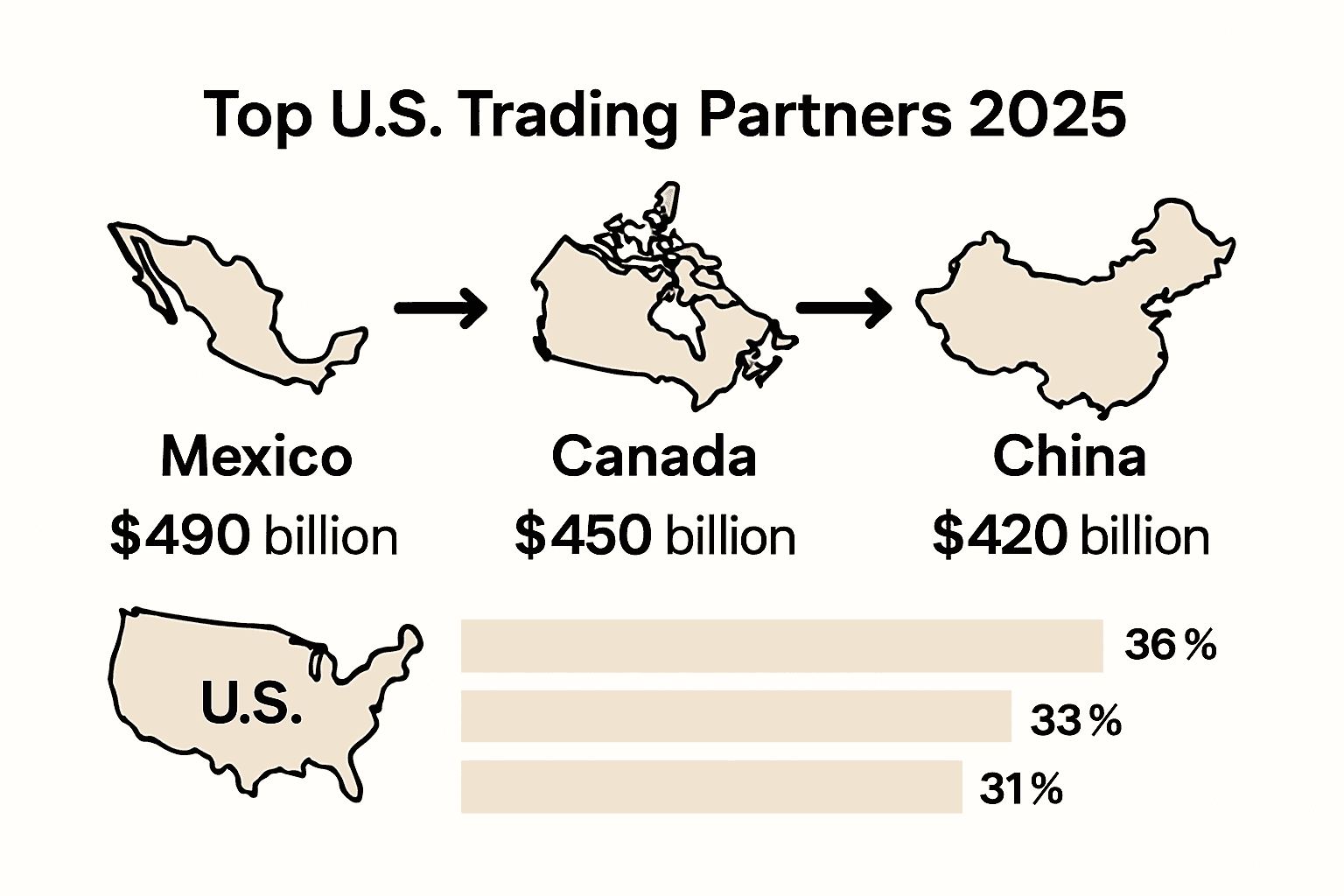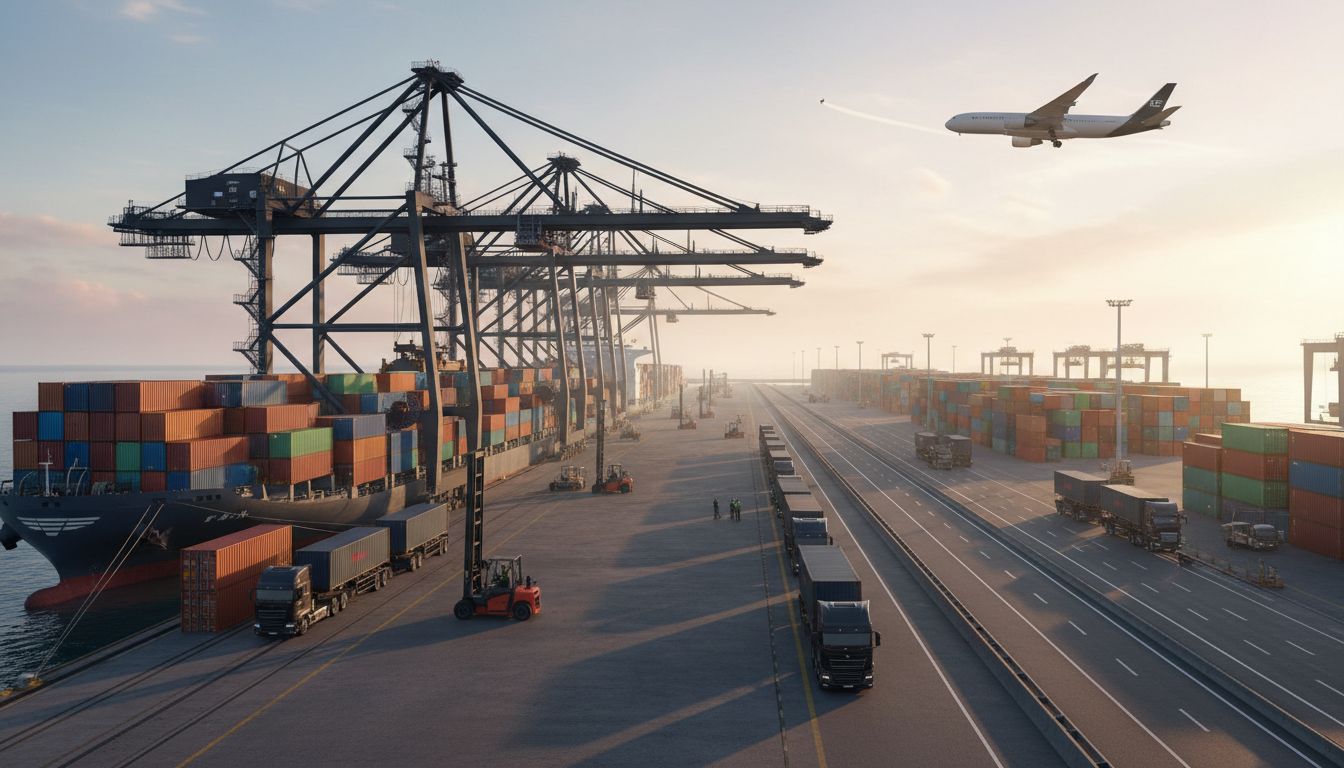Over $3.3 trillion worth of goods crossed U.S. borders in 2024, making the question of where that money flows more urgent than ever. Trade ties shape business risks, supply chains, and pricing for every importer or exporter. As trade powerhouses shift and new policies reshape old routines, knowing which countries lead as top trading partners helps companies make smarter moves on the world stage.
Key Takeaways
| Point | Details |
|---|---|
| Top Trading Partner Dynamics | Mexico has surpassed Canada and China, leading U.S. trade with 15.8% of total goods trade, highlighting significant shifts in international economic relationships. |
| Key Export Commodities | Top exports for the U.S. include civilian aircraft parts and petroleum products, underscoring transportation and energy as critical sectors within the trading landscape. |
| Challenges from Tariffs | Tariffs have reshaped sourcing strategies, particularly in the automotive and agricultural sectors, creating an environment of increased costs and supply chain disruptions. |
| Compliance and Logistics Issues | Changes in regulations, such as the elimination of the de minimis exemption, have led to complex compliance challenges and logistical bottlenecks for international shipping. |
Table of Contents
- Defining Top Trading Partners For The USA
- Major Trading Partners And Trade Statistics
- Key Import And Export Commodities
- Impact Of Trade Relationships On U.S. Businesses
- Logistics, Compliance, And Common Trade Challenges
Defining Top Trading Partners for the USA
Understanding the top trading partners of the United States is crucial for businesses engaged in international commerce. According to the U.S. Census Bureau, the global trade landscape has experienced significant shifts in 2024, with Mexico emerging as the leading trading partner, surpassing traditional heavyweight partners like Canada and China. Mexico now accounts for approximately 15.8% of total goods trade, signaling a transformative year in international economic relationships.
The top three trading partners for the USA in 2024 demonstrate the complex dynamics of global trade networks. Learn more about trade finance solutions that can help businesses navigate these intricate international relationships. These partners represent diverse economic strengths:
- Mexico: Emerged as the top trading partner, highlighting robust manufacturing and supply chain integrations
- Canada: Maintains a strong second position, leveraging geographical proximity and integrated economic sectors
- China: Continues to be a significant player despite geopolitical tensions and shifting trade policies
Trading partnerships are not just about volume but also about strategic economic interdependence.
 While raw trade numbers are important, they reflect deeper connections in manufacturing, technology transfer, agricultural exchanges, and complex global supply chains. Businesses looking to expand internationally must understand these nuanced relationships and the evolving trade dynamics that shape global economic interactions.
While raw trade numbers are important, they reflect deeper connections in manufacturing, technology transfer, agricultural exchanges, and complex global supply chains. Businesses looking to expand internationally must understand these nuanced relationships and the evolving trade dynamics that shape global economic interactions.
Major Trading Partners and Trade Statistics
The global trade landscape reveals a complex economic network where the United States plays a pivotal role. According to projected 2025 trade volumes from US Import Data, the top trading partners demonstrate remarkable economic diversity and interconnectedness. Mexico leads with $839.9 billion (16.1% of total trade), followed closely by Canada at $699.6 billion (13.4%), and China at $532.4 billion (10.2%), painting a nuanced picture of international economic relationships.
Here’s a summary of the top U.S. trading partners and their trade characteristics:
| Country | 2025 Trade Volume | % of Total U.S. Trade | Key Export Commodities to U.S. |
|---|---|---|---|
| Mexico | $839.9 billion | 16.1% | Vehicles Machinery Agricultural goods |
| Canada | $699.6 billion | 13.4% | Energy Automotive Agricultural products |
| China | $532.4 billion | 10.2% | Electronics Machinery Apparel |
| Germany | N/A | N/A | Cars Medical devices Engineering products |
| Japan | N/A | N/A | Cars Machinery Medical instruments |
Import volumes provide additional insights into these trading dynamics. In 2024, the United States imported approximately $3.3 trillion in goods, with five key countries dominating the landscape:
- Mexico: Leading in exports of vehicles, machinery, and agricultural products
- China: Significant technological and manufactured goods supplier
- Canada: Strong in energy, automotive, and agricultural exports
- Germany: Renowned for high-quality manufacturing and engineering products
- Japan: Known for advanced technological and automotive exports
Learn more about import export basics to navigate these complex international trade relationships. These trade statistics aren’t just numbers – they represent intricate global supply chains, economic interdependencies, and the sophisticated networks that drive international commerce. Understanding these relationships is crucial for businesses seeking to expand their global footprint and leverage international trade opportunities.

Key Import and Export Commodities
The United States maintains a diverse and robust portfolio of export and import commodities that reflect its complex global economic position. According to US Import Data, the top export commodities in 2024–25 showcase the breadth of American industrial and technological capabilities. Civilian aircraft parts lead the pack at $123 billion, followed by crude petroleum at $115 billion and refined petroleum products at $110 billion, demonstrating the significant role of transportation and energy sectors in U.S. international trade.
Each major trading partner brings unique commodities to the international marketplace:
- Mexico: Vehicles, machinery, agricultural products
- China: High-tech goods like smartphones and computers
- Canada: Energy products and agricultural goods
- Germany: Automotive and medical products
- Japan: Vehicles, machinery, medical instruments
Learn more about importing goods to understand the complexities of these international trade flows. Beyond the raw numbers, these commodities represent intricate global supply chains, technological innovations, and the interconnected nature of modern international commerce. The diversity of these exports and imports highlights the United States’ role as a key player in global economic networks, capable of producing and consuming a wide range of high-value goods across multiple critical industries.
Impact of Trade Relationships on U.S. Businesses
The evolving landscape of international trade has profound implications for U.S. businesses, creating both challenges and opportunities for strategic adaptation. According to research from the University of Wisconsin Spring Economic Scorecard, tariffs implemented since 2017 have fundamentally reshaped sourcing strategies and supply chain configurations for American companies. Trade relationships have become increasingly complex, demanding sophisticated navigation of geopolitical and economic dynamics.
The current trade environment presents significant challenges:
- Supply Chain Disruption: Tariffs on imports from Canada and Mexico creating higher input costs
- Sector-Specific Impact: Particularly severe effects in automotive and agricultural industries
- Strategic Adaptation: Businesses forced to diversify sourcing and reconfigure international partnerships
- Cost Pressures: 25% tariffs driving up production and procurement expenses
Learn more about international trade compliance to effectively manage these intricate business challenges. The ongoing trade tensions underscore the critical need for businesses to remain agile, develop robust contingency plans, and continuously reassess their international trade strategies. While these relationships present significant challenges, they also offer opportunities for innovative companies to differentiate themselves by developing more resilient and adaptable global business models.
Logistics, Compliance, and Common Trade Challenges
The international trade landscape has become increasingly complex, with regulatory changes creating significant challenges for businesses and logistics providers. According to Time Magazine, the U.S. elimination of the de minimis duty exemption for imports under $800 has triggered a dramatic shift in cross-border shipping dynamics. This policy change has prompted over 25 countries’ postal services to suspend shipments to the United States, creating unprecedented logistical bottlenecks and disrupting global e-commerce operations.
Key trade compliance challenges facing businesses include:
- Customs Documentation: Increasingly stringent and complex requirements
- Shipping Restrictions: Major carriers suspending certain international deliveries
- Cost Implications: Higher expenses related to new regulatory frameworks
- Operational Complexity: Increased administrative burden for importers and exporters
Learn more about sustainability in logistics to understand how businesses are navigating these intricate challenges. The financial financial implications are substantial, with companies forced to redesign shipping strategies, invest in comprehensive compliance systems, and potentially restructure international supply chains. These evolving regulations underscore the critical importance of adaptability, technological integration, and proactive compliance management in modern international trade.
Simplify Global Trade with Proven Logistics Solutions
Facing complex trade regulations, shifting tariffs, and supply chain disruptions can make international business feel overwhelming. As highlighted in this complete 2025 guide, evolving compliance rules and unpredictable logistics have left many importers and exporters searching for stability and reliability in their operations. If you are struggling with customs documentation, compliance updates, or managing international shipments, you are not alone. The need for expertise in handling customs clearance and seamless supply chain management is more important than ever.

Let Worldwide Express, Inc. be your strategic partner in overcoming these challenges. With decades of industry experience and a full suite of logistics services, including customs brokerage and global freight forwarding, we streamline your trade with top U.S. partners. Explore our Uncategorized Solutions or head to our main site to learn how our specialists can protect your shipments and optimize your global reach. Take control of your supply chain today and ensure your goods move smoothly, no matter where you trade next.
Frequently Asked Questions
What are the top trading partners for the USA in 2025?
The top trading partners for the USA in 2025 are Mexico, Canada, and China, with Mexico leading with $839.9 billion in trade.
What are the key export commodities of the USA?
The top export commodities of the USA include civilian aircraft parts, crude petroleum, and refined petroleum products, reflecting the country’s strengths in transportation and energy.
How have trade relationships affected U.S. businesses?
Trade relationships have created challenges such as supply chain disruptions and increased costs due to tariffs, prompting U.S. businesses to adapt their sourcing strategies and reconfigure supply chains.
What common compliance challenges do businesses face in international trade?
Businesses face compliance challenges such as increasingly complex customs documentation, shipping restrictions, and higher costs related to new regulatory frameworks.
Recommended
- Master Importing Food Products: Step-by-Step US Guide – Worldwide Express, Inc.
- How to Import from China: Step-by-Step Business Guide – Worldwide Express, Inc.
- How to Import Goods: A Step-by-Step Guide for Success – Worldwide Express, Inc.
- Master the Export Documentation Process in 2025 – Worldwide Express, Inc.






